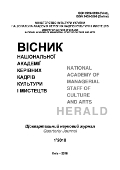THE DESTRUCTIVE IMPACT OF TEMPERATURE AND HUMIDITY SIMULTANEOUSLY ON MUSEUM CARPETS WITH NATURAL COMBINED FIBER (WOOL, COTTON AND SILK)
DOI:
https://doi.org/10.32461/2226-3209.1.2018.178366Анотація
Abstract. Iranian carpet consists of organic matters of wool, cotton and silk and based on their high
vulnerability against environmental conditions needs exact maintenance. There are some factors with direct effect on carpet destruction as temperature and humidity. Temperature and humidity destroy carpets and they are threats against these works or provide the conditions in which other factors damage the carpets. This is a threat against conservation of these works. Bad climate, the effect of high humidity and temperature can increase the molds and can destroy organic matters including carpets. This study is empirical-analytic. At first, based on museum carpets, the samples are taken and they are under bad temperature and humidity conditions. By different tests, tensile strength tests of length (according to national standard NO. 1147-1 with reference ISO13934-1:1999), tensile strength of width (according to national standard 1147-1 with reference ISO13934-1:1999), lint strength (according to national standard 894, reference ISO4919:1978), color stability with grey criterion (according to national standard 160 with reference ISO105-A03:1993) and color stability against rubbing (according to national standard 204 with reference ISO105-X12:2001), destructions of museum carpets are defined and preventive solutions of museum carpets against temperature and humidity are presented.
Keywords: Silk, Wool, Cotton, Natural combined fiber, temperature, humidity, carpet, museum.
Посилання
Abdel-Kareem, O., 2010. Conservation and restoration of a rare large Persian carpet. E-Conservation
Magazine, 17, pp.53-63.
Riederer, Jose f. 1987. Restaurieren Restoration & Bewahren Preservation, berlin.
Brooks, M., Lister, A., Eastop, D. and Bennett, T., 1996. Artifact or information? Articulating the conflicts in
conserving archaeological textiles. Studies in Conservation, 41(sup1), pp.16-21.
Rodrigues, I. 2005, Textile Conservation at UNL, Department of Conservation and Restoration, New University
of Lisbon.
Plenderleith, H.J.1976. Maintenance antiques and art museums, London.
Reddy, M.K., Suneela, M., Sumathi, M. and Reddy, R.C., 2005. Indoor air quality at Salarjung Museum,
Hyderabad, India. Environmental monitoring and assessment, 105(1-3), pp.359-367.
Bacci, M., Cucci, C., Mencaglia, A.A. and Mignani, A.G., 2008. Innovative sensors for environmental monitoring
in museums. Sensors, 8(3), pp.1984-2005.
Armindo, E., Sousa, M., Melo, M.J. and Hallett, J.A., 2008, September. A Persian carpet's paradise garden:
discovering historical and technical aspects through carpet conservation and restoration. In Proceedings of
ICOM-CC 15th Triennial Conference, New Delhi (p. 824e31).
Heiden, K. and Niemeyer, S., 1994. NF94-200 Making Choices About Salvaging Wet or Flood Damaged
Carpet. Historical Materials from University of Nebraska-Lincoln Extension, p.1439.
Pfeifer, G., Brauneck, P. 2008. Courtyard Houses: A Housing Typology,Berlin, Springer.
Shelley, M., 1987. The care and handling of art objects: practices in the Metropolitan Museum of Art.
Metropolitan Museum of Art.
Parvathi, C., Maruthavanan, T. and Prakash, C., 2009. Environmental impacts of textile industries. The Indian
Textile Journal, 22.
Potter, M. 1914. Clothes Moths & Carpet Beetles: Fabric Insect Pests, How to Identify, Prevent, Control, &
Repair the Damage Bette Jo Dedic, Extension Clothing Specialist and Extension Entomologist.
Perkins, Z.A., Brako, J. and Mann, R., 1990. Woven traditions, the integration of conservation and restoration
techniques in the treatment of Oriental rugs. Textile Museum journal, 29, pp.13-25.
Hutchison, R.B., 1990. From restoration to conservation: parallels between the traditions of tapestry conservation
and carpet conservation. Textile Museum Journal, 29, pp.9-12.
Henry, B., 2012. Understanding the environmental impacts of wool: A review of life cycle assessment
studies. International Wool Textile Organisation, Brussels.
Schober, G., 1991. Fungi in carpeting and furniture dust. Allergy, 46(8), pp.639-643.
Plenderleith, H.J. and Werner, A.E., 1971. The conservation of antiquities and works of art: treatment, repair and
restoration. Oxford University Press.
Black, M.S. L.M, Work, A.G, Worthan. W.J, Pearson. 1993, The Chemicals on our carpets and Textiles ’93:
Proceedings of the 6th international conference on indoor air and climate. Helsinki, Finland, 6: 575-579.
Sousa, M., Melo, M.J., Aguiar-Ricardo, A. and Cruz, P., 2005. A green approach to antique textile cleaning.
In Triennial meeting (14th), The Hague, 12-16 September 2005: preprints (pp. 944-953). James & James.
Fahey, M.M., 2005. The Care and Preservation of Antique Textiles and Costumes.
Pedram, B. 2008. The special issues of repair knowledge. Ph.D. course of repair of historical cultural objects.
Fine Arts University of Isfahan.
##submission.downloads##
Номер
Розділ
Ліцензія
Автори, які публікуються у цьому журналі, погоджуються з наступними умовами:
1. Автори залишають за собою право на авторство своєї роботи та передають журналу право першої публікації цієї роботи на умовах ліцензії Creative Commons Attribution License, котра дозволяє іншим особам вільно розповсюджувати опубліковану роботу з обов'язковим посиланням на авторів оригінальної роботи та першу публікацію роботи у цьому журналі.
2. Автори мають право укладати самостійні додаткові угоди щодо неексклюзивного розповсюдження роботи у тому вигляді, в якому вона була опублікована цим журналом (наприклад, розміщувати роботу в електронному сховищі установи або публікувати у складі монографії), за умови збереження посилання на першу публікацію роботи у цьому журналі.
3.Політика журналу дозволяє і заохочує розміщення авторами в мережі Інтернет (наприклад, у сховищах установ або на особистих веб-сайтах) рукопису роботи, як до подання цього рукопису до редакції, так і під час його редакційного опрацювання, оскільки це сприяє виникненню продуктивної наукової дискусії та позитивно позначається на оперативності та динаміці цитування опублікованої роботи.

